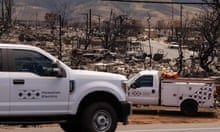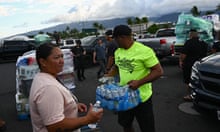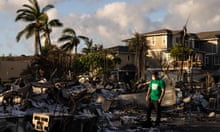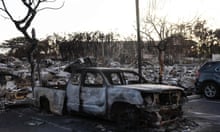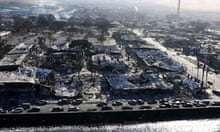Long before fast-moving flames descended on the historic town of Lahaina, the growing threats of catastrophic fire in western Maui were clear.
Acres of abandoned farmland that line the picturesque coastal communities played perfect host to invasive grasses that are primed to burn, creating tinderbox conditions as the island’s landscapes dried and warmed.
Devastating blazes, once a rarity across Hawaii, are increasing in furiousness and scale, driving a 400% increase in average area burned across the archipelago in the last century. The growing threat has outpaced preparedness measures and the resources available to fight them.
This week’s tragedy, expected to be one of the deadliest fire disasters to hit the island chain, marks a grim milestone in an escalating issue. As crews continue to try to contain the flames and assess the devastating toll the fires have taken on lives and livelihoods, experts are expecting a long recovery – and warning of a fiery future.
“That is one of the devastating parts here – we knew this could happen,” said Andrea Barretto, the co-executive director of the Hawaii Wildfire Management Organization, a non-profit dedicated to prevention and recovery. “The reality of our fire risk is we are just now catching up to it.”
The organization released a preparedness plan for west Maui communities roughly a decade ago, and Maui county listed Lahaina and other nearby communities at risk of wildfire damage in its hazard mitigation plan, last updated in 2020. The threats have only increased in recent years, according to Barretto, who added that limited resources have further stifled preparedness efforts as conditions intensified.
“They are doing the very best considering the limitations and challenges they are experiencing,” she said of the fire crews who are spread thin. “We haven’t had a lot of experience with these devastating fires,” Barerro added. “You can have a plan on paper, but it doesn’t mean it is going to turn into effective implementation unless you have practiced it.”
The cause of the brush fire that erupted earlier this week is still under investigation, but a cocktail of fire conditions quickly aligned to create the catastrophe that followed as the blaze exploded toward homes and businesses. Whipped by strong winds, the fire rapidly outpaced efforts made by the small local firefighting force to keep it contained.
“It was a perfect storm – literally. There were just a confluence of factors that lined up to essentially wipe this town off the map,” the climate scientist Daniel Swain said during a discussion broadcast on YouTube on Friday. “This fire moved so fast that some people didn’t even make it out of their buildings. It engulfed buildings within a matter of 60 to 120 seconds.”

Bobby Lee, the president of the Hawaii Firefighters Association, told CBS news that crews in Maui county are limited to only 65 firefighters who are responsible for battling ignitions across three islands. All their fire engines – just over a dozen with two ladder trucks – are only equipped for navigating city roads, limiting the ability to attack blazes before they reach communities.
The rapid onslaught of the fire, fueled by strong gusty winds through difficult terrain, also complicated containment. “You’re basically dealing with trying to fight a blowtorch,” Lee told CBS news. “You’ve got to be careful – you don’t want to get caught downwind from that, because you’re going to get run over in a wind-driven fire of that magnitude.”
Records show that the sirens that were intended to warn the residents of the incoming inferno never sounded, according to Hawaii emergency management agency spokesperson Adam Weintraub. Emergency alerts sent to mobile phones, televisions, and radio stations may not have been received due to widespread power outages.
“On west Maui, that fire with those winds and the fuel that was surrounding that community – there wasn’t time,” Barretto said. “There wasn’t time to put out the word for people to evacuate.”
While the unique set of conditions that contributed to this tragedy set it apart from other fire disasters that are increasingly common across the American west, there are commonalities, according to Swain, who drew comparisons to Colorado’s 2021 Marshall fire and even the deadly Camp fire that left the town of Paradise, California, in ruins in 2018.
But a key devastating difference lies in the landscapes themselves, as Hawaii’s lush ecosystems are ill-adapted for fire. Even as communities brace for a long and difficult recovery ahead, the destructive aftermath is expected to linger.
“When we have fire like that, it doesn’t just threaten communities and infrastructure and natural resources,” Barretto said, sharing concerns that the rain to come will send soil down the slopes that will smother coral reefs. “The impacts are massive and long lasting,” she added. “We don’t have what the west coast has, in terms of good and bad fire – all fire is bad fire in Hawaii.”

